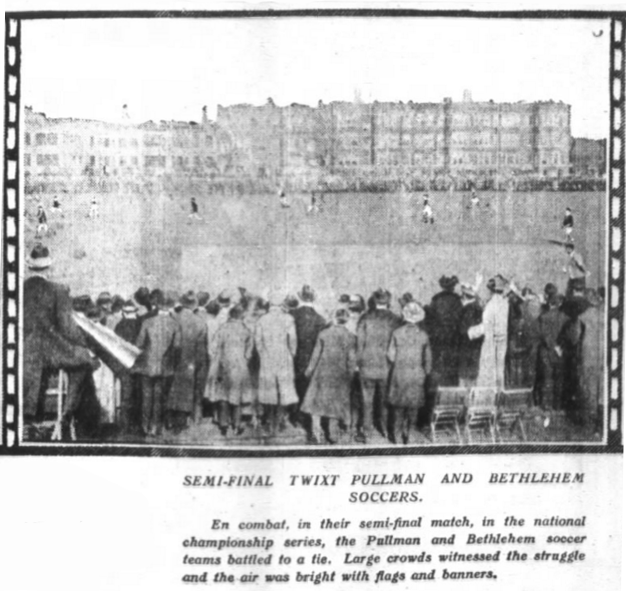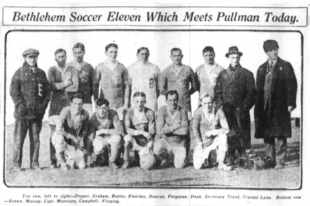Photo: Bethlehem Steel. From the Chicago Daily Tribune, April 16, 1916
Draws and winter weather would prove to be a continuing factor in Bethlehem Steel’s campaign for a second National Challenge Cup championship in the 1915-1916 edition of the tournament, known today as the U.S. Open Cup.
Early round play began easily for the Steelworkers, with the team defeating Blue Mountain League side Bethlehem East Ends, 9-0, in the first round on November 13, 1915. In the second round, Bethlehem drew 1-1 against American League their rivals in Philadelphia’s American League, Disston, formerly the Tacony FC team, on December 11, 1915. Bethlehem would prevail in the replay on Christmas Day, 3-0, in an ugly contest the Philadelphia Inquirer described as “one of the poorest played games of the season.”
In the third round on January 15, 1916, Bethlehem hosted American League side Hibernians on a frozen East End Field in zero degree temperatures, finishing the day 6-0 winners.
Bethlehem drew the West Hudson team of Harrison, New Jersey for the fourth round, although winter weather and poor field conditions would see the match postponed four times before the teams met at Federal League Park in Newark on April 2.

Philadelphia Inquirer, April 3, 1916
Bethlehem came out strong from the start of play, taking the 1-0 lead within the first 15 minutes from a penalty kick from outside left Thomas “Whitey” Fleming. The Philadelphia Inquirer reported on April 3, 1916 the West Hudson right fullback “in attempting to clear misjudged the ball and then had the misfortune to ‘fist’ it twelve yards from goal.”
In the end, despite a late push from the home team in the final 15 minutes of the game, Fleming’s goal proved to be enough to advance to the semifinals. The Inquirer reported that while “the combination play of the winners could not been improved upon,” finishing was a problem. “The National Cup champions should have scored more than one goal, for they had numerous chances to score, but their front liners dallied with the ball too long when in close proximity to the Jersey’s goal, with the result that they were either robbed of the ball by one of their opposing backs or else when they had a clear goal their shooting was wide of the mark. Practically every forward on the winning team should have scored. In fact, Bethlehem easily had two-thirds of the game in their favor but they were too overanxious and in consequence this proved their failing.”
With the victory, Bethlehem would be on the road again, this time to face Chicago’s Pullman FC on April 16. It would be the longest journey yet taken for a game in the short history of the national championship tournament.
Another draw
Pullman FC had made it as far as the quarterfinals in the 1913-1914 National Challenge Cup, losing 2-1 to Niagara Falls Rangers in the inaugural edition of the tournament, reaching the quarterfinals again in the 1914-15 tournament only to lose to the Homestead Steel Works team of Pittsburgh by the same scoreline after extra time. In the 1915-1916 series, Pullman finally broke their quarterfinal curse, defeating Cleveland’s Thistles 3-1 on the road.
The Chicago Daily Tribune reported on April 11 of the home team’s preparations for their Pennsylvania foe, “For several weeks the Carbuilders have been drilling after work on their own field, which is close to the Pullman works, and have been exercising in the Palmer park gymnasium.” The report noted it was to the Pullman team’s advantage that it had its own field and a gymnasium to train but that Bethlehem “had similar advantages” thanks to the “strong financial support” given to the Steelworkers by President Charles Schwab of the Bethlehem Steel Company.
The April 16 fixture fell on a Sunday and the Bethlehem Globe reported on April 12, “Arrangements have been made in the event of the grounds being unfit or wet weather to play the game on Monday.” Kickoff was scheduled for 3 pm but, the Globe reported on April 13, “As there is a difference of about one hour in time between Chicago and Bethlehem, it will be 4 p.m. here before the game is started. The half time and full time scores will be wired to Western Union office Main Street, Bethlehem. Half time scores should reach here around 6 p.m. and final scores about 8 p.m.”
Bethlehem Steel departed for Chicago via rail on Friday, April 14, traveling on the Lehigh Valley Railroad first to Buffalo before heading to Chicago on the Lake Shore Limited. Despite travelling aboard “a special Pullman,” it was a long journey of more than 24 hours that finished in Chicago only 16 hours before the match. The game would be played at the Hyde Park Blues grounds, which had been lengthened to 110 yards for the semifinal. The Chicago Daily Tribune reported on April 14 that Pullman would be wearing red, Bethlehem royal blue.
Previewing the match on the day of the game, J.G. Davis wrote in the Daily Tribune that Bethlehem “comes with the reputation of being the best balanced team ever gathered in this country, but the bubble of reputation will not scare the Carbuilders,” despite the Steelworkers being undefeated in 20 league and cup games, outscoring its opponents 89 goals to 10. A wire report in the April 16 edition of the Philadelphia Inquirer described, “the men from Pennsylvania look like the most formidable team that has ever visited Chicago with the exception of the Corinthian and Pilgrim teams of England.” Davis’ preview emphasized the similarities between Bethlehem and the “champion of the west,” writing, “It looks like Greek meeting Greek, Pullman having a shade in that it is playing before a home crowd.”
Following a 30 minute exhibition game between two Chicago youth teams, the semifinal tie kicked off before 4,000 spectators in conditions that Davis reported in the Daily Tribune as “well nigh perfect.” After 12 minutes of play, Bethlehem outside left Fleming was the first to take a shot at goal, but his shot was wide. Few real chances followed before the teams changed sides for the second half.

Chicago Daily Tribune, April 23, 1916
The Daily Tribune reported that by the second half the teams “were playing great football and the crowd was kept on edge as each territory was in turn invaded.” But by the end of regulation time the scoreline line remained level at 0-0. The first period of extra time was “full of action” but “while both goals were threatened, the defense men held the upper hand.” Play slowed down in the second extra time period and, with darkness descending, the final whistle saw the game scoreless.
Davis wrote in his match recap for the Daily Tribune on April 17, 1916 that Bethlehem had been “the cooler side in the matter of attack, its passing showing more of the real art of the kicking code…Against a less brilliant defense they would have been able to get to close range many times, but the carbuilders were all over the field.” The Bethlehem defense also “had no weak spots” and was equally stout. As Davis described, “The remarkable feature was the scarcity of dangerous shots on goal.”
The teams would meet for the semifinal replay in Bethlehem on April 22 at Lehigh University’s Taylor Stadium. A report in the Philadelphia Inquirer on April 18 noted, “The local steel team has posted a forfeit for $1000 to guarantee the expenses of the Pullmans…The receipts of the Chicago game…are said to have been between $1500 and $1600, which is considered good for the small price of admission. It cost the Bethlehem Steel team about $800 to make the trip West.”
Bethlehem advances to the 1915-1916 National Challenge Cup final
Some 3,500 spectators came to Taylor Stadium for the April 22 semifinal replay. Rain throughout the night before the game made for slippery conditions but fans were treated to a thrilling Cup tie that featured a relentless Bethlehem attack against an inspired Pullman defense, particularly on the part of the visitors’ American-born goalkeeper Holmes.
The Philadelphia Inquirer match report on April 23, 1916 described Pullman’s attack as “snappy” at the start of the game, and the visitors produced the first attempt on goal, which was easily handled. A Bethlehem corner kick came to naught but was soon followed three goal attempts “in quick order” that called upon Holmes”to clear the ball from the mouth of goal.”
Bethlehem finally broke through the Pullman’s defense before the end of the half when “on a long pass from the middle of the field [center forward] Clarke broke loose, and headed into the net, both he and Holmes going into the net with the sphere.” The Bethlehem attack did not let up before the halftime whistle, but the score remained 1-0 at the end of the first period of play.

Philadelphia Inquirer, April 23, 1916
Pullman came out in the second half pressing for an equalizer. Their efforts were rewarded when a Bethlehem player handled the ball in the box. The Inquirer reported, “It was during a scrimmage in the penalty area that [inside right] Pepper in turning accidentally touched the ball with his left forearm. [Pullman center forward] Shallcross took the kick and made good, [Bethlehem goalkeeper] Duncan never having a chance to save.” The Inquirer report continued, “After this Pullman braced wonderfully and Bethlehem seemed to slump.”
But, with ten minutes of regulation time remaining, Bethlehem came alive. The Inquirer described, “Three times in a row, due to the Pullman fouling, free kicks from non-dangerous angles were given Bethlehem, but these kicks led to the steel workers forcing Pullman into four consecutive corner kicks.”
Three times the Bethlehem corners came to naught. “But the fourth played its part in that it landed in from the net, a scrimmage resulting. Captain Morrison, who was playing back, saw an opening and the ball at the same time and rushing in fast, sent the sphere spinning into the net. Then the final whistle blew.”
Bethlehem would meet Fall River Rovers in the final of the 1915-1916 National Challenge Cup at Coates Field in Pawtucket, Rhode Island, on May 6, 1916.


Thanks Ed. As usual the old stuff is a great read….”sent the sphere spinning into the net” no body today would write that…but they should!!
sehr gut gemacht